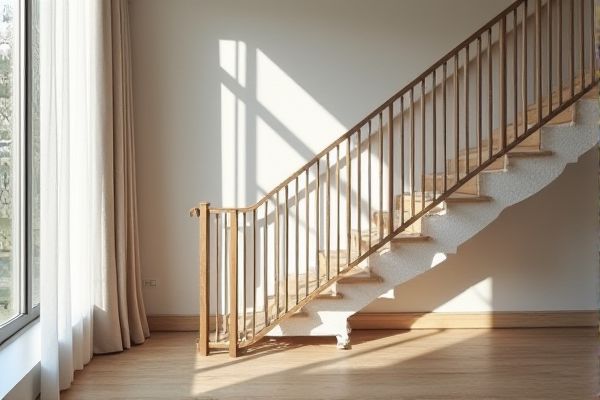
Minimalist railing emphasizes clean lines and simplicity, offering a sleek, unobtrusive design that complements modern spaces while enhancing safety. Exploring the balance between minimalist and decorative railing options can help you choose the perfect style for your home's aesthetic and functionality--continue reading to discover key factors and examples.
Table of Comparison
| Feature | Minimalist Railing | Decorative Railing |
|---|---|---|
| Design Style | Simple, clean lines | Ornate, intricate patterns |
| Material | Steel, glass, aluminum | Wrought iron, wood, metal |
| Cost | Moderate to low | Higher due to craftsmanship |
| Maintenance | Low, easy to clean | Moderate to high, requires upkeep |
| Installation | Quick, straightforward | Complex, time-consuming |
| Aesthetic Impact | Modern, sleek look | Traditional, artistic appeal |
| Customization | Limited options | Highly customizable |
| Durability | High, resistant to damage | Varies by material and design |
Introduction to Railing Design Styles
Minimalist railing design emphasizes clean lines, simple forms, and functional aesthetics, often using materials like stainless steel, glass, or powder-coated metal to create an unobtrusive appearance. Decorative railing incorporates intricate patterns, ornate details, and various textures, frequently crafted from wrought iron, wood, or cast aluminum to enhance visual interest. Choosing between minimalist and decorative railings depends on the architectural style and desired ambiance, balancing safety with design intent.
What Is a Minimalist Railing?
A minimalist railing features clean lines, simple geometric shapes, and lacks ornate details, emphasizing functionality and subtle elegance. It often uses materials like steel, glass, or wood with thin profiles to create an unobtrusive barrier that complements modern architectural styles. Minimalist railings contrast with decorative railings, which incorporate intricate patterns, embellishments, and traditional craftsmanship for visual impact.
Defining Decorative Railing
Decorative railing emphasizes intricate designs, ornamental patterns, and artistic elements that enhance aesthetic appeal while serving safety functions. Unlike minimalist railing, which prioritizes simplicity and clean lines, decorative railing often incorporates wrought iron, carved wood, or custom metalwork to create visual interest. This style suits architectural projects seeking to make a bold statement or reflect traditional craftsmanship through elaborate detailing.
Key Differences Between Minimalist and Decorative Railings
Minimalist railings emphasize clean lines, simple geometry, and often use materials like stainless steel and glass to create an unobtrusive look that complements modern architecture. Decorative railings prioritize intricate designs, ornate patterns, and materials such as wrought iron or wrought steel, enhancing aesthetic appeal and character in traditional or eclectic settings. The key differences lie in their design intent, with minimalist railings focusing on functionality and subtlety, while decorative railings serve as a focal point and artistic expression.
Materials Used in Minimalist vs. Decorative Railings
Minimalist railings typically utilize materials such as stainless steel, glass, and aluminum, emphasizing sleek lines and functionality with minimal ornamentation. Decorative railings often incorporate wrought iron, brass, or wood, featuring intricate patterns and embellishments that enhance visual appeal. Your choice of railing material impacts durability, maintenance, and overall aesthetic, aligning with the desired style and architectural context.
Aesthetic Impact on Interior and Exterior Spaces
Minimalist railing features clean lines and simple materials, enhancing the spaciousness and modern appeal of interior and exterior spaces by emphasizing openness and unobstructed views. Decorative railing incorporates intricate designs and ornamental details, adding character and visual interest that complement traditional or eclectic architectural styles. Both types influence the overall aesthetic by defining the space's style--minimalist railings promote a sleek, contemporary look while decorative railings create a sense of elegance and craftsmanship.
Maintenance and Durability Considerations
Minimalist railings, typically made from materials like stainless steel or glass, offer superior durability and require minimal maintenance due to their sleek, simple design that resists dirt accumulation and corrosion. Decorative railings, often crafted from wrought iron or intricate woodwork, may require regular upkeep such as repainting, rust prevention, and repairs to preserve their aesthetic appeal and structural integrity. Choosing minimalist railings reduces long-term maintenance costs and enhances longevity, making them ideal for modern, low-maintenance architectural settings.
Cost Comparison: Minimalist vs. Decorative Railings
Minimalist railings typically cost less than decorative railings due to their simple design and use of fewer materials, often focusing on sleek metal or glass panels. Decorative railings involve intricate patterns, custom designs, and additional materials like wrought iron or ornamental elements, driving up labor and material expenses. Homeowners seeking budget-friendly options usually prefer minimalist railings, while those investing in aesthetic appeal may opt for the higher costs of decorative railings.
Choosing the Right Railing for Your Space
Minimalist railing offers sleek, unobtrusive lines that enhance modern spaces by maximizing light and openness, making it ideal for contemporary interiors or areas seeking a clean, simple aesthetic. Decorative railing features intricate designs and ornamental details, providing a focal point that adds character and elegance, suitable for traditional or eclectic environments. Selecting the right railing depends on the architectural style, desired visual impact, and functional needs of the space to ensure harmony and safety.
Final Thoughts: Minimalist or Decorative?
Minimalist railings emphasize sleek lines, simplicity, and unobtrusive design, enhancing modern spaces with a clean aesthetic. Decorative railings incorporate intricate patterns and ornamental details, serving as focal points that add character and personality to interiors. Choosing between minimalist or decorative railings depends on the desired visual impact and architectural style of the space.
 homyna.com
homyna.com